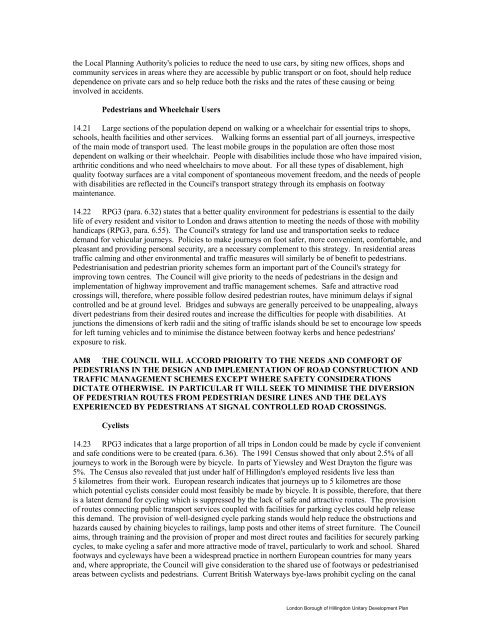HILLINGDON UNITARY DEVELOPMENT PLAN - London Borough ...
HILLINGDON UNITARY DEVELOPMENT PLAN - London Borough ...
HILLINGDON UNITARY DEVELOPMENT PLAN - London Borough ...
Create successful ePaper yourself
Turn your PDF publications into a flip-book with our unique Google optimized e-Paper software.
the Local Planning Authority's policies to reduce the need to use cars, by siting new offices, shops and<br />
community services in areas where they are accessible by public transport or on foot, should help reduce<br />
dependence on private cars and so help reduce both the risks and the rates of these causing or being<br />
involved in accidents.<br />
Pedestrians and Wheelchair Users<br />
14.21 Large sections of the population depend on walking or a wheelchair for essential trips to shops,<br />
schools, health facilities and other services. Walking forms an essential part of all journeys, irrespective<br />
of the main mode of transport used. The least mobile groups in the population are often those most<br />
dependent on walking or their wheelchair. People with disabilities include those who have impaired vision,<br />
arthritic conditions and who need wheelchairs to move about. For all these types of disablement, high<br />
quality footway surfaces are a vital component of spontaneous movement freedom, and the needs of people<br />
with disabilities are reflected in the Council's transport strategy through its emphasis on footway<br />
maintenance.<br />
14.22 RPG3 (para. 6.32) states that a better quality environment for pedestrians is essential to the daily<br />
life of every resident and visitor to <strong>London</strong> and draws attention to meeting the needs of those with mobility<br />
handicaps (RPG3, para. 6.55). The Council's strategy for land use and transportation seeks to reduce<br />
demand for vehicular journeys. Policies to make journeys on foot safer, more convenient, comfortable, and<br />
pleasant and providing personal security, are a necessary complement to this strategy. In residential areas<br />
traffic calming and other environmental and traffic measures will similarly be of benefit to pedestrians.<br />
Pedestrianisation and pedestrian priority schemes form an important part of the Council's strategy for<br />
improving town centres. The Council will give priority to the needs of pedestrians in the design and<br />
implementation of highway improvement and traffic management schemes. Safe and attractive road<br />
crossings will, therefore, where possible follow desired pedestrian routes, have minimum delays if signal<br />
controlled and be at ground level. Bridges and subways are generally perceived to be unappealing, always<br />
divert pedestrians from their desired routes and increase the difficulties for people with disabilities. At<br />
junctions the dimensions of kerb radii and the siting of traffic islands should be set to encourage low speeds<br />
for left turning vehicles and to minimise the distance between footway kerbs and hence pedestrians'<br />
exposure to risk.<br />
AM8 THE COUNCIL WILL ACCORD PRIORITY TO THE NEEDS AND COMFORT OF<br />
PEDESTRIANS IN THE DESIGN AND IMPLEMENTATION OF ROAD CONSTRUCTION AND<br />
TRAFFIC MANAGEMENT SCHEMES EXCEPT WHERE SAFETY CONSIDERATIONS<br />
DICTATE OTHERWISE. IN PARTICULAR IT WILL SEEK TO MINIMISE THE DIVERSION<br />
OF PEDESTRIAN ROUTES FROM PEDESTRIAN DESIRE LINES AND THE DELAYS<br />
EXPERIENCED BY PEDESTRIANS AT SIGNAL CONTROLLED ROAD CROSSINGS.<br />
Cyclists<br />
14.23 RPG3 indicates that a large proportion of all trips in <strong>London</strong> could be made by cycle if convenient<br />
and safe conditions were to be created (para. 6.36). The 1991 Census showed that only about 2.5% of all<br />
journeys to work in the <strong>Borough</strong> were by bicycle. In parts of Yiewsley and West Drayton the figure was<br />
5%. The Census also revealed that just under half of Hillingdon's employed residents live less than<br />
5 kilometres from their work. European research indicates that journeys up to 5 kilometres are those<br />
which potential cyclists consider could most feasibly be made by bicycle. It is possible, therefore, that there<br />
is a latent demand for cycling which is suppressed by the lack of safe and attractive routes. The provision<br />
of routes connecting public transport services coupled with facilities for parking cycles could help release<br />
this demand. The provision of well-designed cycle parking stands would help reduce the obstructions and<br />
hazards caused by chaining bicycles to railings, lamp posts and other items of street furniture. The Council<br />
aims, through training and the provision of proper and most direct routes and facilities for securely parking<br />
cycles, to make cycling a safer and more attractive mode of travel, particularly to work and school. Shared<br />
footways and cycleways have been a widespread practice in northern European countries for many years<br />
and, where appropriate, the Council will give consideration to the shared use of footways or pedestrianised<br />
areas between cyclists and pedestrians. Current British Waterways bye-laws prohibit cycling on the canal<br />
<strong>London</strong> <strong>Borough</strong> of Hillingdon Unitary Development Plan
















